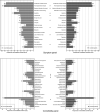Patient Characteristics, Diagnostic Delays, Treatment Patterns, Treatment Outcomes, Comorbidities, and Treatment Costs of Acromegaly in China: A Nationwide Study
- PMID: 33335513
- PMCID: PMC7736552
- DOI: 10.3389/fendo.2020.610519
Patient Characteristics, Diagnostic Delays, Treatment Patterns, Treatment Outcomes, Comorbidities, and Treatment Costs of Acromegaly in China: A Nationwide Study
Abstract
Purpose: Acromegaly is a rare, intractable endocrine disease. We aimed to describe the patient characteristics, diagnostic delays, treatment patterns, treatment outcomes, comorbidities and treatment costs of acromegaly in China.
Methods: This is a nationwide cross-sectional study. Patients diagnosed with and treated for acromegaly between 1996 and 2019 across China were surveyed via the Chinese Association of Patients with Acromegaly platform.
Results: In total, 473 patients (58.8% females, mean age at diagnosis: 39.4±9.5 years) were included. The median disease duration was 3 years. The most common symptoms were extremity enlargement (91.8%) and facial changes (90.1%). Overall, 63.0% of patients experienced diagnostic delays within healthcare systems; 63.8% of the delays were <1 year. The most common first-line therapy was surgery with a transsphenoidal (76.1%) or transcranial approach (3.2%). Somatostatin analogues or dopamine agonists were administered in 20.5% of the patients as first-line therapies and in 41.7% as adjuvant therapies. Radiotherapy was performed in 32.1% of patients, 99.3% of whom received radiotherapy as an adjuvant therapy. After a median 5-year follow-up, 46.2% achieved biochemical control. Comorbidities were reported in 88.2% of the patients at follow-up; memory deterioration and thyroid nodules were the most common. Controlled patients had greater improvements in symptoms and comorbidities during follow-up than uncontrolled patients. The annual per-capita cost-of-treatment was $11013 in 2018, with medical treatments being the largest contributor (67%). Medical insurance covered 47.2% of all treatment costs.
Conclusion: This study provides the first comprehensive description of real-world acromegaly data in China, serving as a basis for future population-based studies.
Keywords: China; acromegaly; comorbidity; diagnostic delay; economic burden; endocrine remission; treatment patterns.
Copyright © 2020 Guo, Wang, Yu, Gao, Wang, Zhu, Xing, Zhang and Dong.
Conflict of interest statement
The authors declare that the research was conducted in the absence of any commercial or financial relationships that could be construed as a potential conflict of interest.
Figures


Similar articles
-
Clinical and Economic Burden of Commercially Insured Patients with Acromegaly in the United States: A Retrospective Analysis.J Manag Care Spec Pharm. 2015 Dec;21(12):1106-12. doi: 10.18553/jmcp.2015.21.12.1106. J Manag Care Spec Pharm. 2015. PMID: 26679960 Free PMC article.
-
Comorbidities, treatment patterns and cost-of-illness of acromegaly in Sweden: a register-linkage population-based study.Eur J Endocrinol. 2017 Feb;176(2):203-212. doi: 10.1530/EJE-16-0623. Epub 2016 Nov 15. Eur J Endocrinol. 2017. PMID: 27932528
-
Prevalence, incidence, comorbidities, and treatment patterns among Japanese patients with acromegaly: a descriptive study using a nationwide claims database.Endocr J. 2020 Oct 28;67(10):997-1006. doi: 10.1507/endocrj.EJ20-0129. Epub 2020 Jun 10. Endocr J. 2020. PMID: 32522909
-
[Epidemiology of acromegaly in Spain].Endocrinol Nutr. 2013 Oct;60(8):470-4. doi: 10.1016/j.endonu.2012.09.010. Epub 2012 Dec 13. Endocrinol Nutr. 2013. PMID: 23246411 Review. Spanish.
-
The real costs of acromegaly: analysis of different therapies.Endokrynol Pol. 2019;70(1):74-85. doi: 10.5603/EP.a2018.0080. Endokrynol Pol. 2019. PMID: 30843180 Review.
Cited by
-
Sub-macroscopic skin presentation of acromegaly and effect of pituitary tumor surgery: A study using dermatoscopy and ultra-high-frequency ultrasound.Front Endocrinol (Lausanne). 2023 Jan 10;13:1093942. doi: 10.3389/fendo.2022.1093942. eCollection 2022. Front Endocrinol (Lausanne). 2023. PMID: 36818464 Free PMC article.
-
Using 2-dimensional hand photographs to predict postoperative biochemical remission in acromegaly patients: a transfer learning approach.Quant Imaging Med Surg. 2023 Jun 1;13(6):3747-3759. doi: 10.21037/qims-22-1101. Epub 2023 Apr 6. Quant Imaging Med Surg. 2023. PMID: 37284118 Free PMC article.
-
Diagnostic Delay of Hereditary Ataxias in Brazil: the Case of Machado-Joseph Disease.Cerebellum. 2023 Jun;22(3):348-354. doi: 10.1007/s12311-022-01404-5. Epub 2022 Apr 14. Cerebellum. 2023. PMID: 35426040
-
Correlation Between Clinical and Biochemical Markers in Patients With Acromegaly on Different Modalities of Treatment.Cureus. 2021 Nov 10;13(11):e19438. doi: 10.7759/cureus.19438. eCollection 2021 Nov. Cureus. 2021. PMID: 34909342 Free PMC article.
-
Use of real world data to improve drug coverage decisions in China.BMJ. 2023 Jun 15;381:e068911. doi: 10.1136/bmj-2021-068911. BMJ. 2023. PMID: 37321633 Free PMC article.
References
Publication types
MeSH terms
Substances
LinkOut - more resources
Full Text Sources

